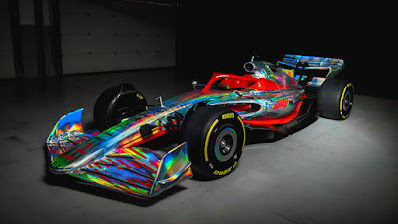1.6 Litre Biturbo:
One way to make the engines exciting even when ,we don't have MGU-H is by increasing the boost .This won't solve the problem of turbolag .But on the straight lanes on the track ,the cars will have higher power outputs and higher revs. So that would compensate for the loss of speed on the curves .The thing which the fans would love the most about such engines is that these engines would sound great and bring back the sound vibe of the v10s ,which the drivers and fans miss alike. The further benefit of the two turbos will be that the availability of two axial flow turbines will allow the designers to make cooling even better .This would further increase the efficiency and power output .
Opposing pistons :
Another ingenious design that the constructors have repeatedly tried to bring forward is the two stroke opposing piston designs .As a fact ,the two strokes have higher effiwcinwxies due to the simpler design and simpler operation that comprises of only two strokes .The only downside : they are very bad for environment. Though not as much as conventional two strokes were .Because the opposing piston design would radically increase efficiency and also would allow the integration of a possible internal lubrication design. So that we might not need to add that engine oil in our fuel .Otherwise else the spectators of the race would probably need to wear masks to save themselves from the high ammaounts of NOx at the track when 20 cars would be revving more than 10000rpm and drinking 6 gallons per mile .This might not sound good enough .Only time will tell .
Rotary Engines :
Okay ,you might not know but there was an ex Ferrari F1 car that was fitted with a 787B 4 rotor rorotary engine from a former Mazda 787B lmp1 car. The benefit : it was a very compact package that despite of its inefficiencies was able to deliver 800 horsepower to the driveshafts. Amazing as it sounds. There inefficiencies might lead you to think they aren't good enough .But with emerging technologies and designs such as the Liquid Piston and Libralato rotary engines ,that make the wankels even more efficient than their reciprocating counterparts will allow the cars to get even better .The rotary engines are indeed the way forward for now . The cars are getting heavier and heavier even when we are now using smaller V6s ,because of the energy recovery systems .And we can't omit these systems because we and FIA have both committed to make our environment greener .So then this is the only option we have then ,the power to weight ratio of rotary engines is amazing and they can rev all the way up to 20000 rpm even ,while piston driven engines are limited to 18000rpm .So why not adapt them ? They are compacter ,lighter, can give even more power due to latest technologies and also give the option of open architecture .
Entry Ignition :
There is one other option too here. .We can't make the F1 go electric until unless 2039 ,because of an agreement between FIA and ABB ,which limits electric formula racing to just Formula E domain .So ,the current eco F1 game is limited to synthetic fuels and better efficiencies. So why don't we use a new type of engine that ensures better efficiency .There is one concept ,known as the entry ignition that theoretically gives 63% efficiency . In this design all the cylinders have different bore and stroke sizes and this engine is essentially a two-stroke engine. Let us consider a four-cylinder layout of this engine. The first cylinder will be a high bore cylinder ,which will only serve to compress the air .The compression ratio of this cylinder is very low .The air then goes into a second cylinder which also serves to only compress the air but at a higher compression ratio .Now before going into a third cylinder ,the air is port injected with fuel .This is done so to let a proper air fuel mixture form .Then the third cylinder has a slider valve in place of a traditional valve .This slider valve opens to let the air enter a very hot third cylinder .This cylinder is kept hot by the exhaust valve closing early so that some exhaust gas ,which is now very hot ,to stay trapped inside .Due to this very hot temperature ,the air fuel mixture ignites upon entry .After this power stroke ,the exhaust gases then travel to a fourth cylinder ,where they are allowed to expand once more to get better efficiency . Now it is a two stroke engine ,because the 2nd and 3rd Cylinders are synchronized ,with the power stroke of 3rd cylinder resulting in the intake stroke of the second .Now the two stage compression ,two stage expansion and the lean air fuel mixture result in a very high efficiency and remove all the problems with HCCI,PCCI and RCCI .But this is still a theoretical concept and there are many things yet to sort out like balancing the engine as all cylinders are not of the same sizes, and the problem of keeping the 3rd cylinder intact even after taking too much heat.
This engine has a theoretical efficiency of 63% as compared to 40 % in the case of Otto cycle though real world numbers will be less .





0 Comments